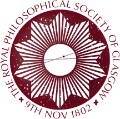Stephen Venables: Everest East Side Story
Review by Croy Thomson

A fortnight ago, the Society talk was from a man drawn towards gravity; this week the speaker has spent a lifetime defying it.
The Chair, Campbell Forrest, introduced Stephen Venables, former President of the Alpine Club and South Georgia Association, a man who abandoned a possible career in theatre to pursue mountaineering (the words High and Drama seem apt: here is the first Brit to climb Everest without additional oxygen).
From start to finish the audience were, appropriately enough, gripped. A quick walk in through Stephen’s schooldays in England, at a school where fabled climbing pioneer George Mallory studied and taught, began to shape the context of the evening’s journey to planet’s highest peak.
Characters of note abounded: meet Radhanath Sikdar the Indian mathematician who accurately calculated the height of Mount Everest as long ago as 1852 (satellites, who needs them?); brilliant Aberdonian scientist-climber Alexander Kellas; the developers of early portable oxygen cylinders (operated via “much palaver”); Norton and Somervell who went within 800 feet of Everest’s summit in 1924 without any of that “oxygen nonsense”.
Stephen’s images were almost literally breathtaking, their impact enhanced by his dimming of the hall lights. We were transported to Tibet’s Kama Valley, through fields of gentians and the giant lilies of the Himalaya (and suburban Edinburgh, evidently). We were kept moving along enjoyably faster than the one-mile-a-day pace Stephen endured on his way into Kangshung. Yaks just don’t have the Scottish work ethic.
Crux of the talk was the 1988 expedition, celebrating the 35th anniversary of Hillary and Tenzing’s ascent. The higher Stephen took us, the greater the appreciation of the rigours of survival at an altitude of 29,000 feet. We learned what might well constitute true courage (the compelling answer was perhaps not what you would expect). We saw what pro climbers look like after going to the limit.
Among many lighter notes we discovered exactly where to go for an avalanche. We now know the proper but never accepted pronunciation of “Everest” (“Eve” not “Evv”), and why mountaineers seldom say, “I wish we’d set off a bit later.” It was all mesmerising stuff, unpacked direct from Stephen’s years of experience. He was articulate, enthralling and entertaining – one particular remark about the ’88 expedition, “The climbing was magnificent: you could almost have been in Cairngorm,” earned happy laughter. As implied by the West Side Story reference in the title, this talk was really a love letter to mountains and mountaineering. There can be few infatuations so seductive. Or dangerous.
This inspiring talk lasted just over an hour, which is as long as it takes to walk 60 metres when up on Everest’s less-travelled East Side. Phew. Cue long applause, and thanks to the Committee.
Q&A samples: Q: What do you think of 21st century Everest mountain tourism? – A: “It’s not mountaineering, it’s a business transaction.”
Q: Did summiting Everest change you?” – A: “Yes. My wife says it made me a much nicer man!”
Q: Have you ever seen a yeti? – A: “No, not as yeti.”
Q: What music did you listen to on your Walkman on the ’88 expedition? – A: … to this one I’m pretty sure Stephen replied, “Brahms & Liszt”, but maybe that was me thinking of the drinks afterwards …(ed. Liszt Piano Sonata, and Brahms Horn Trio)
Stephen recommends reading ‘Into The Silence’ by Wade Davis (Subtitled The Great War, Mallory and the Conquest of Everest). I recommend any of Stephen’s own books, as well as the online edition of his talk. Let’s all savour the oxygen of knowledge.
